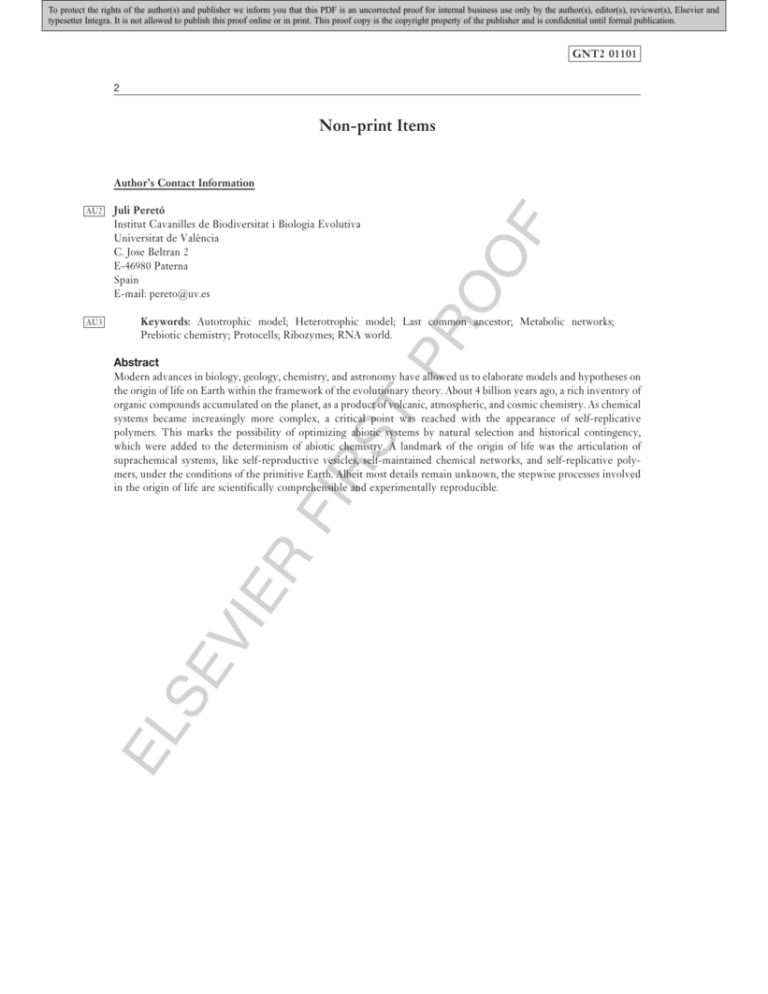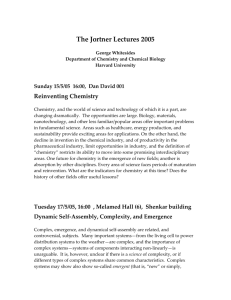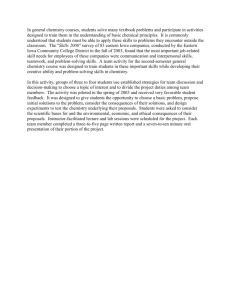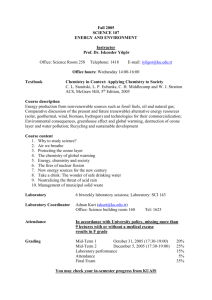
To protect the rights of the author(s) and publisher we inform you that this PDF is an uncorrected proof for internal business use only by the author(s), editor(s), reviewer(s), Elsevier and
typesetter Integra. It is not allowed to publish this proof online or in print. This proof copy is the copyright property of the publisher and is confidential until formal publication.
GNT2 01101
2
Non-print Items
Author’s Contact Information
F
OO
AU3
Juli Peretó
Institut Cavanilles de Biodiversitat i Biologia Evolutiva
Universitat de València
C. Jose Beltran 2
E-46980 Paterna
Spain
E-mail: pereto@uv.es
Keywords: Autotrophic model; Heterotrophic model; Last common ancestor; Metabolic networks;
Prebiotic chemistry; Protocells; Ribozymes; RNA world.
PR
AU2
EL
SE
VI
ER
FI
RS
T
Abstract
Modern advances in biology, geology, chemistry, and astronomy have allowed us to elaborate models and hypotheses on
the origin of life on Earth within the framework of the evolutionary theory. About 4 billion years ago, a rich inventory of
organic compounds accumulated on the planet, as a product of volcanic, atmospheric, and cosmic chemistry. As chemical
systems became increasingly more complex, a critical point was reached with the appearance of self-replicative
polymers. This marks the possibility of optimizing abiotic systems by natural selection and historical contingency,
which were added to the determinism of abiotic chemistry. A landmark of the origin of life was the articulation of
suprachemical systems, like self-reproductive vesicles, self-maintained chemical networks, and self-replicative polymers, under the conditions of the primitive Earth. Albeit most details remain unknown, the stepwise processes involved
in the origin of life are scientifically comprehensible and experimentally reproducible.
To protect the rights of the author(s) and publisher we inform you that this PDF is an uncorrected proof for internal business use only by the author(s), editor(s), reviewer(s), Elsevier and
typesetter Integra. It is not allowed to publish this proof online or in print. This proof copy is the copyright property of the publisher and is confidential until formal publication.
GNT2 01101
a0005
Origin of Life, Theories of
J Peretó, Universitat de València, Paterna, Spain
© 2012 Elsevier Inc. All rights reserved.
This article is a revision of the previous edition article by E Szathmáry, volume 3, pp 1387–1394, © 2001, Elsevier Ltd.
d0010
s0005
Origin of Life: A Brief Historical Overview
p0005 Spontaneous generation was the mechanism invoked to
d0025
his work allowed abandoning the pure speculation, whereas
imposing the experimental rigor to the study of origin of life on
Earth.
In 1953, the pioneering experiments of Stanley L. Miller, p0015
under the supervision of Harold C. Urey, initiated prebiotic
chemistry as the search of the most plausible reactions and
compounds participating in the origin of primitive life. Other
contextual factors that favored the development of the scientific
search for the origin of life were (1) the development of the
spatial programs during the Cold War, the analytical study of
extraterrestrial materials, as meteorites, and the advance of
cosmochemistry; (2) the emergence of a molecular approach
to evolution in 1960s, using the sequences of macromolecules
as historical documents and allowing in the 1970s the inference of a universal tree of life and the maturity of the notion of
a common ancestor (cenancestor) to all living forms; (3) the
development of micropaleontology, that is, the study of the
oldest signatures of life on Earth; (4) the discovery of extremophiles, allowing the expansion of the physical conditions
compatible with life; and (5) the discovery in 1981 of the
catalytic abilities of RNA (ribozymes). Today, the scientific
study of the origin of life must be considered as the study of
the beginnings of life evolution, a foundational chapter of
evolutionary biology.
VI
ER
FI
RS
T
account for the emergence of life in the first evolutionary
theories. Thus, in 1802 Jean-Baptiste Lamarck proposed that
the more primitive living forms would emerge spontaneously
in the lowest extreme of each evolutionary line, whereas
Charles Darwin (ca. 1837) would admit that “the intimate
relation of Life with laws of chemical combination, and the
universality of latter render spontaneous generation not
improbable”. Even after the seminal experimental work by
Louis Pasteur and John Tyndall demonstrated the impossibility
of the spontaneous generation of microorganisms, it appeared
that any materialistic scenario for the origin of life would
require some form of sudden appearance of living entities.
Darwin and some of his most prominent followers, as Ernst
Haeckel, adopted this idea. Others affiliated with more
eccentric ideas, like possibility of the eternity of life panspermia
(i.e., the distribution of life germs from planet to planet), or the
intervention of supernatural forces precisely at the beginning of
life, a neovitalistic ideology that has recently resurrected under
the form of the intelligent design movement.
Toward the turn of the twentieth century, major developp0010
ments in our understanding of the chemical and physical
processes of living matter led to a more sharp formulation of
the question of the origin of life on the primitive Earth. In
1926, Hermann J. Muller suggested that the first living form
had been a gene that had appeared by chance in the primitive
ocean and that was endowed from the start with the possibilities of replication, catalysis, and mutability. In 1929, John B.
Haldane proposed the existence of a primitive soup, that is, a
hot diluted solution of organic compounds in the oceans, as
the cradle for the emergence of viruses, which at that moment
he considered as the missing link between chemistry and life.
Nevertheless, the first successful attempt to collect all the contemporary knowledge on chemistry, geology, astronomy, and
biology to picture a framework for life’s origins was the booklet
The Origin of Life, published in Russian in 1924 by Aleksandr I.
Oparin. His ideas would slowly permeate the Western scientific
community after the English translation (1938) of his more
extended work of 1936. It is evident that the scientific details of
Oparin’s narrative are obsolete. But what is important is that
F
Abiotic chemistry Set of molecules and processes that do
no involve any biological intervention.
Prebiotic chemistry Set of organic molecules and
processes that supposedly were directly involved in the
origin of primitive life.
d0015
d0020
OO
d0005
Ribozyme A RNA molecule with catalytic abilities.
Spontaneous generation The sudden transformation of
inert matter into living beings.
Universal cenancestor The common ancestor of all
terrestrial living beings.
PR
Glossary
EL
SE
AU1
Origin of Life: A Survey of Possible Scenarios
s0010
The current controversies on the origin of life have deep histor- p0020
ical and philosophical roots. In this sense, the scientific
discussion of life emergence does not differ from other intellectual conflicts in biology and has developed through
different, sometimes incompatible, models (Figure 1). Thus,
the whole diversity of processes and scenarios, the abiotic generation of chemical complexity in the primitive Earth, both
endogenous (atmosphere, sea surface, submarine chimneys)
and exogenous (meteorites, comets, interstellar dust particles),
and the role of minerals (catalysis and stability) and of different energy sources (electromagnetic, chemical) invite us to an
eclectic vision of the origin-of-life problem where the heterogeneity of mechanisms and conditions will be essential to
assemble a coherent historical narrative.
1
To protect the rights of the author(s) and publisher we inform you that this PDF is an uncorrected proof for internal business use only by the author(s), editor(s), reviewer(s), Elsevier and
typesetter Integra. It is not allowed to publish this proof online or in print. This proof copy is the copyright property of the publisher and is confidential until formal publication.
GNT2 01101
2
Origin of Life, Theories of
Extraterrestrial origins (Panspermia: Arrhenius, Crick ...)
Inorganic (e.g., clay organisms: Cairns-Smith)
Exogenous delivery: Cosmochemistry
F
Heterotrophic
C source = organics
Terrestrial origins
OO
Endogenous syntheses: Geochemistry
Organic
Chemosynthetic
Energy source = radox inorganic chemistry
Autotrophic
C source = CO2
PR
Photosynthetic
Energy source = light
f0005 Figure 1 A survey of models on the origin of life.
suprachemical subsystems exhibiting basic lifelike properties,
including self-reproductive vesicles, self-replicative polymers,
and self-maintained chemical networks, appear to have been
a necessary step during the chemical evolution or prebiotic
phase (Figure 2). Eventually, the harmonic articulation of
those three prebiotic subsystems in the same functional framework could be considered as the beginning of biological
evolution. Thus, any evolutionary scenario, to be complete,
must give an explicit account for the mechanisms of energy
and matter fluxes through these primitive systems.
Some authors prefer a radically different perspective by p0040
assuming that life started with metabolic routes. Instead of a
T
s0015 Where?
p0025 Although some contemporary scientists (most remarkably
FI
RS
Francis Crick) have proposed the panspermia hypothesis,
there are no fundamental reasons to suppose an origin of life
outside the planet Earth. Some scientists still speculate that life
originated on Mars and then contaminated planet Earth or the
other way around. The exploration of Mars under this perspective deserves attention.
s0020 When?
p0030 Life on Earth is a very old phenomenon. Studies on chemical
VI
ER
and isotopic composition and the search for microfossils in the
oldest sedimentary rocks suggest the existence of a diverse,
abundant microbiota at least 3.5 billion years (Ga) ago. The
current consensus about the requirement of liquid water for life
sets an upper limit for the temporal window for life emergence
on 4.1 Ga before present when the first oceans were likely in
place.
Universal cenancestor
DNA/RNA/protein world
RNA/protein world
EL
SE
s0025 How? Heterotrophic vs. Autotrophic
RNA world
p0035 Following the Oparin tradition, it is generally assumed that life
originated with a heterotrophic metabolic mode, that is, from a
‘primitive soup’ rich in organic compounds from which the
first organisms gained energy and matter (Figure 1). During
the last decades, scientists have accumulated many data favoring the contributions of volcanic, atmospheric, and cosmic
chemistries to the inventories of abiotic compounds and processes in the early Earth. Contributions from laboratory
simulations and the analyses of meteorites have been of paramount importance in this context. However, prebiotic chemists
know very well that one of the major problems they face is the
geochemical relevance of the reactions under scrutiny. Since
our knowledge about the earliest terrestrial environments is so
fragmentary and incomplete, to decide which component of
abiotic chemistry – that is, geo or cosmochemical compounds
or processes – is prebiotically relevant will always be a challenge. It is generally accepted that the emergence of
Protocell (BMR)
Protometabolism (M)
Boundary (B)
Replicator (R)
Prebiotic chemistry
Abiotic chemistry
Geochemistry
Cosmochemistry
Figure 2 The transition from abiotic chemistry to biochemistry and the f0010
universal cenancestor.
To protect the rights of the author(s) and publisher we inform you that this PDF is an uncorrected proof for internal business use only by the author(s), editor(s), reviewer(s), Elsevier and
typesetter Integra. It is not allowed to publish this proof online or in print. This proof copy is the copyright property of the publisher and is confidential until formal publication.
GNT2 01101
Origin of Life, Theories of
OO
F
existence of chemomimetic processes, that is, the occurrence of
organo-chemical mechanisms in abiotic processes that
anticipate the kind of chemistry to be used by the first
biochemical transformations. The protometabolic model by
de Duve explores the notion of congruence, that is, the continuity between the chemical world of a prebiotic phase,
basically determined by the participation of nongenetically
instructed catalysts (e.g., minerals, short oligomers), the
chemistry of a protometabolism using replicative polymers
(e.g., RNA) as catalysts (i.e., ribozymes), and present-day
metabolic pathways. The very moment that replicative polymers appear on scene, natural selection would automatically
emerge, and historical contingency would add to the purely
chemical processes. The discovery of the oldest traces of life
chemistry in current metabolic networks is hindered by the
multiple ways life has adapted to a fabulous diversity of environments. Many metabolic innovations erased the older faces of
biochemistry.
PR
heterotrophic scenario (where a chemically rich environment is
the cradle for simple chemical changes upon which protometabolic networks would eventually develop), an autotrophic
origin based on the energy and electrons released from redox
reactions involving mineral compounds and the synthesis of
organic matter from CO2 is postulated (Figure 1). According to
some of these schemes, a primitive form of the reductive tricarboxylic acid (Krebs) cycle would be the initial seed of a
prebiotic chemistry that prefigured most of modern metabolism. Another model, with partial experimental support,
postulates that the anaerobic synthesis of pyrite from H2S and
FeS would serve as a source of electrons and energy for chemical syntheses from CO2 throughout the same autotrophic
route. Still other scenario involves a geochemical version of
the metabolic synthesis of acetate from CO or CO2 present in
some anaerobic microorganisms. In these cases, submarine
hydrothermal settings would offer the thermal and chemical
gradients required by the models.
How? Early or Late Cellularization
s0030 How? Replication vs. Metabolism
p0045 Many authors equate the origin of life to the origin of first
s0035
Whether compartment formation is an early or late phenom- p0055
enon during life origin is a debate closely related with the
above mentioned on the early origin of metabolism or genetics. AU5
Many advocates of an early emergence of replicators consider
the cell as a mere physical compartment for segregating polymers that show differential replicative abilities. However,
membranes are active players in bioenergetic transduction.
Some authors propose that life would be cellular ab initio,
although there are many issues still controversial, including
the chemical nature of the membranes and the kind of primitive molecular transducers of primary energy sources, prior to
the existence of intricate protein machines. Experimental
approaches on vesicle chemistry point to fatty acids as good
candidates as the first amphiphilic protocellular constituents.
EL
SE
VI
ER
FI
RS
T
replicators. Theoretical and experimental insights and the discovery of ribozymes brought about a renovated interest on the
idea of an early emergence of genetic polymers. This is one of
the fundamental postulates of the ‘RNA world hypothesis’.
According to this model, one of the early life stages was dominated by RNA acting both as genetic polymer and catalytic
agent in primitive metabolism (Figure 2). The evidence that
in extant ribosomes RNA itself catalyzes the synthesis of the
peptidic bond reinforces the antiquity and centrality of ribozymes. Comparative genomics extended to all life forms offers
a window to the metabolic complexity of the universal cenancestor, since most universally conserved genes code for
RNA-related functions. Experimental approaches, such as
in vitro RNA evolution, support the chemical plausibility of an
RNA world. Several laboratories are very close to one of the key
postulates of this scenario, namely the synthesis of an RNA that
could catalyze its own template-directed replication. However,
a satisfactory explanation for the emergence of a chemically
complex polymer as RNA remains elusive. The extreme implausibility of the prebiotic emergence of a genetic polymer like
RNA has led to consider alternative models that favor the
self-organization of chemical networks as the material and
energetic cradle for self-replicative polymers. This approach is
often known as ‘metabolism first’, emphasizing the absence of
a genetic polymer. Actually, this is a rather old debate initially
confronting those supporters of an early origin of genes (even
before their chemical nature was established, e.g., Herman J.
Muller ideas in the 1920s) or the emergence of proteins first
(e.g., Leonard Troland in the 1910s).
p0050
How would it be possible for a highly ordered (e.g., polymers synthesized from energetically and chirally pure
monomers) without a plausible and efficient way for funneling
AU4 the energy through the system? Several authors have advocated
for the appearance of primitive self-catalytic chemical networks
as a first step toward the synthesis of replicators. Those
self-organized prebiotic processes would provide a scaffold
for the emergence of genetics. One question to be addressed
is whether there is a congruence or continuity between prebiotic chemistry and biochemistry. Several authors consider the
3
Synthetic Biology and the Empirical Approach
to the Origin of Life
s0040
The bottom-up approach to the synthesis of living systems p0060
relies on the assumption that fundamental properties of life
(for instance, autopoiesis or self-construction, self-replication,
etc.) can be chemically implemented in a test tube. There is a
clear epistemological continuity with the ultimate aims of the
research program of prebiotic chemistry. For Oparin ‘the artificial building or synthesis of living things is a very remote, but
not an unattainable goal along this road (leading to the ultimate knowledge of the nature of life)’. For Haldane, the ideas
on life origins would remain speculative ‘until living creatures
have been synthesized in the biochemical laboratory’.
Today, the experimental road for the study of the plausibil- p0065
ity of the transition from chemistry to biology focuses mainly
on two aspects: the biophysics of artificial membranes and
vesicles of a simple character and the chemistry of
self-replicating RNA polymers. The final goal is the building
of a system of self-reproductive vesicles containing catalytic
RNAs that are able both to make more copies of the same
RNAs (self-replicative) and catalyze the synthesis of the boundary components from simpler chemical substrates. A legitimate
philosophical question would be whether this supra-chemical
To protect the rights of the author(s) and publisher we inform you that this PDF is an uncorrected proof for internal business use only by the author(s), editor(s), reviewer(s), Elsevier and
typesetter Integra. It is not allowed to publish this proof online or in print. This proof copy is the copyright property of the publisher and is confidential until formal publication.
GNT2 01101
4
Origin of Life, Theories of
(or infra-biological) constructs should be considered alive or
not. This is one of the reasons of the renewed interest on
AU6 defining life.
Further Reading
Gargaud M, López-García P, and Martin H (eds.) (2011) Origins and Evolution of Life: An
Astrobiological Perspective. Cambridge: Cambridge University Press.
Miller SL (1953) A production of amino acids under possible primitive Earth conditions.
Science 117: 528–529.
Ricardo A and Szostak JW (2009) Origin of life on Earth. Scientific American 301(3):
54–61.
Yarus M (2010) Life from an RNA World: The Ancestor Within. Cambridge: Harvard
University Press.
bib0030
bib0035
bib0040
bib0045
bib0015
bib0020
http://evolution.berkeley.edu – Evolution 101 (University of California, Berkeley).
http://exploringorigins.org – Exploring Life’s Origins.
http://tinyurl.com – John Maynard Smith lecture on the origin of life at the Royal Society
of London.
http://www.springer.com – Journal: Origins of Life and Evolution of Biospheres.
http://issol.org – The International Society for the Study of the Origin of Life.
EL
SE
VI
ER
FI
RS
T
PR
bib0025
Relevant Websites
OO
bib0010
evolution and the nature of the last common ancestor of the three major cell
domains. Annual Review of Ecology, Evolution, and Systematics 38: 361–379.
Bedau M and Cleland C (2010) The Nature of Life: Classical and Contemporary
Perspectives from Philosophy and Science. Cambridge: Cambridge University Press.
Deamer D (2011) First Life: Discovering Connections between Stars, Cells, and How Life
Began. Berkeley, CA: University of California Press.
Deamer D and Szostak JW (eds.) (2010) The Origins of Life. Cold Spring Harbor, NY:
Cold Spring Harbor Laboratory Press.
de Duve C (2005) Singularities: Landmarks on the Pathways of Life. Cambridge:
Cambridge University Press.
F
bib0005 Becerra A, Delaye L, Islas S, and Lazcano A (2007) The very early stages of biological
bib0050 AU7
bib0055
bib0060
bib0065
bib0070
To protect the rights of the author(s) and publisher we inform you that this PDF is an uncorrected proof for internal business use only by the author(s), editor(s), reviewer(s), Elsevier and
typesetter Integra. It is not allowed to publish this proof online or in print. This proof copy is the copyright property of the publisher and is confidential until formal publication.
GNT2 01101
Origin of Life, Theories of
5
OO
F
Biographical Sketch
EL
SE
VI
ER
FI
RS
T
PR
Juli Peretó is an associate professor of biochemistry and molecular biology at the University of Valencia, and a member of the Evolutionary Genetics
group of the Institute Cavanilles for Biodiversity and Evolutionary Biology. His research interest centers in the origin and evolution of the metabolic
networks, the concept of minimum genome, and the history of the ideas on the natural origin and the artificial synthesis of life. He has introduced the
teaching of the origin and primitive evolution of the life at the University of Valencia and dedicated many efforts to evolutionary thought outreach
through conferences, seminars, courses, books, exhibitions, and documentary films, addressed especially to high-school students and their teachers.
He has been Vice-rector of the University of Valencia (1994–2002) and Secretary (2005–08) and Second Vice President (2011–14) of the
International Society for the Study of the Origin of Life (ISSOL).








